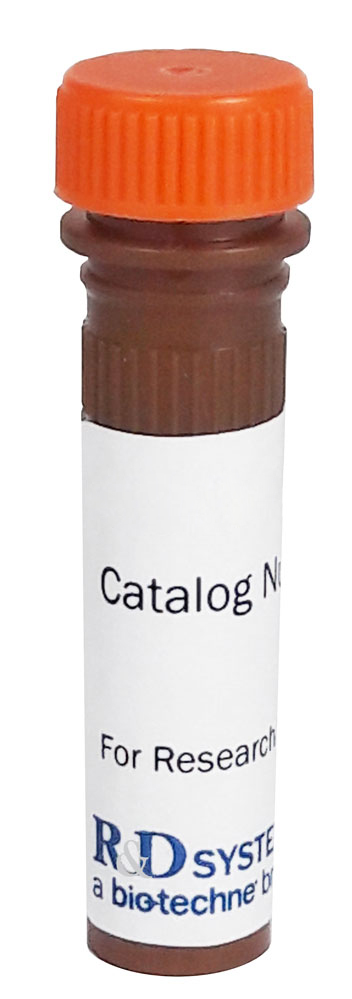Human EphB6 Alexa Fluor® 750-conjugated Antibody Summary
Val17-Thr579
Accession # O15197
Applications
Please Note: Optimal dilutions should be determined by each laboratory for each application. General Protocols are available in the Technical Information section on our website.
Reconstitution Calculator
Preparation and Storage
Background: EphB6
EphB6, also known as Hep and Mep, is a 110 kDa member of the Eph receptor tyrosine kinase family. The A and B classes of Eph proteins are distinguished by ligand preference and have a common structural organization (1‑4). The human EphB6 cDNA encodes a 1006 amino acid (aa) precursor that includes a 16 aa signal sequence, a 563 aa extracellular domain (ECD), a 21 aa transmembrane segment, and a 406 aa cytoplasmic domain. The ECD contains serine- and cysteine-rich regions and two fibronectin type-III domains. The cytoplasmic domain contains one non-catalytic protein kinase-like, one proline-rich, one SAM, and one PDZ-binding domain (5, 6). Within the ECD, human EphB6 shares 91% aa sequence identity with mouse and rat EphB6. It shares 38‑45% aa sequence identity with human EphB1, 2, 3, 4, and 6. Human EphB5 has not been characterized. Two secreted splice variants have been described in mouse but not in human (6). EphB6 is primarily expressed in brain, pancreas, thymus, and peripheral T cells (5, 7, 8). EphB6 forms stable heterodimers with EphB1 and participates in signal transduction by association with other enzymatically active molecules (9‑11). Ephrin-B2 is the dominant ligand for EphB6, although Ephrin-B1 and Ephrin-B3 can also trigger responses (12‑14). High concentrations of Ephrin-B2 inhibit cell adhesion and migration as well as tyrosine phosphorylation of EphB6. Conversely, low concentrations of Ephrin-B2 promote adhesion and migration and do not lead to EphB6 phosphorylation (15). The level of EphB6 expression is inversely correlated with tumor aggressiveness in a variety of malignancies (1). EphB6 also functions as a T cell co-stimulatory molecule (8, 11, 13). EphB6 clusters with the T cell receptor and participates in the subsequent attenuation of the T cell response (8, 10, 11, 13).
- Surawska, H. et al. (2004) Cytokine Growth Factor Rev. 15:419.
- Poliakov, A. et al. (2004) Dev. Cell 7:465.
- Wu, J. and H. Luo (2005) Curr. Opin. Hematol. 12:292.
- Pasquale, E.B. (2005) Nat. Rev. Mol. Cell Biol. 6:462.
- Matsuoka, H. et al. (1997) Biochem. Biophys. Res. Commun. 235:487.
- Gurniak, C.B. and L.J. Berg (1996) Oncogene 13:777.
- Hafner, C. et al. (2004) Clin. Chem. 50:490.
- Luo, H. et al. (2002) J. Clin. Invest. 110:1141.
- Freywald, A. et al. (2002) J. Biol. Chem. 277:3823.
- Freywald, A. et al. (2003) J. Biol. Chem. 278:10150.
- Luo, H. et al. (2001) J. Immunol. 167:1362.
- Munthe, E. et al. (2000) FEBS Lett. 466:169.
- Luo, H. et al. (2004) J. Clin. Invest. 114:1762.
- Shimoyama, M. et al. (2002) Biochem. Biophys. Res. Commun. 298:87.
- Matsuoka, H. et al. (2005) J. Biol. Chem. 280:29355.
Product Datasheets
Product Specific Notices
This product is provided under an agreement between Life Technologies Corporation and R&D Systems, Inc, and the manufacture, use, sale or import of this product is subject to one or more US patents and corresponding non-US equivalents, owned by Life Technologies Corporation and its affiliates. The purchase of this product conveys to the buyer the non-transferable right to use the purchased amount of the product and components of the product only in research conducted by the buyer (whether the buyer is an academic or for-profit entity). The sale of this product is expressly conditioned on the buyer not using the product or its components (1) in manufacturing; (2) to provide a service, information, or data to an unaffiliated third party for payment; (3) for therapeutic, diagnostic or prophylactic purposes; (4) to resell, sell, or otherwise transfer this product or its components to any third party, or for any other commercial purpose. Life Technologies Corporation will not assert a claim against the buyer of the infringement of the above patents based on the manufacture, use or sale of a commercial product developed in research by the buyer in which this product or its components was employed, provided that neither this product nor any of its components was used in the manufacture of such product. For information on purchasing a license to this product for purposes other than research, contact Life Technologies Corporation, Cell Analysis Business Unit, Business Development, 29851 Willow Creek Road, Eugene, OR 97402, Tel: (541) 465-8300. Fax: (541) 335-0354.
FAQs
No product specific FAQs exist for this product, however you may
View all Antibody FAQsReviews for Human EphB6 Alexa Fluor® 750-conjugated Antibody
There are currently no reviews for this product. Be the first to review Human EphB6 Alexa Fluor® 750-conjugated Antibody and earn rewards!
Have you used Human EphB6 Alexa Fluor® 750-conjugated Antibody?
Submit a review and receive an Amazon gift card.
$25/€18/£15/$25CAN/¥75 Yuan/¥2500 Yen for a review with an image
$10/€7/£6/$10 CAD/¥70 Yuan/¥1110 Yen for a review without an image


